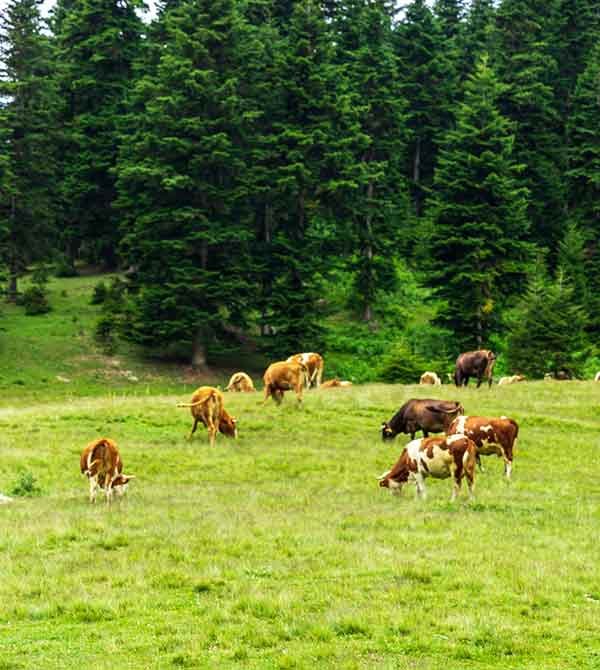Nguni Cattle
- Temperature:0°C (50°F) and 30°C (86°F)
- Milk:2 and 5 liters of milk per day
- Food:Concentrates, Hay and silage
- Pregnancy:9 months or 280-285 days
- Nationality:Africa

General Information
Nguni cattle are a breed of cattle that originated in southern Africa and are highly valued for their hardiness, adaptability, and resilience. They are a small to medium-sized breed that comes in a variety of colors and patterns, including black, white, brown, and speckled.
Nguni cattle are well adapted to the harsh environmental conditions of southern Africa and are able to thrive in areas with limited grazing and water resources. They are also resistant to many of the diseases and parasites that can affect other breeds of cattle.
In addition to their adaptability and resilience, Nguni cattle are also highly valued for their meat and milk production. Their meat is known for its high quality and flavor, while their milk is often used to make traditional dairy products such as butter and cheese.
Where we find this cow to buy?
Nguni cattle are primarily found in southern Africa, particularly in countries like South Africa, Zimbabwe, Mozambique, and Swaziland.
If you are looking to purchase Nguni cattle, your best bet would be to look for breeders or livestock auctions in these regions.
There are also several organizations and programs that promote the conservation and breeding of Nguni cattle, and these may be able to provide information on where to purchase Nguni cattle.
One such organization is the Nguni Cattle Breeders’ Society in South Africa.
It is important to note that importing live animals may be subject to various regulations and restrictions, so it is important to check with your local authorities before attempting to import Nguni cattle from another country.

How to increase milk production in Nguni Cattle
There are several ways to increase milk production in Nguni cattle:
01
Providing Nguni cows with a balanced diet that is high in energy, protein, and fiber can help increase milk production.
02
Proper milking technique is essential to ensure all milk is extracted from the udder and to avoid discomfort or injury to the cow.
03
Providing Nguni cows with a clean and reliable source of water is important for maintaining their health and milk production.
04
Select cows with high milk production records and good udder conformation to increase milk production in Nguni cattle.
Medicine
There are various medicines and treatments available for Nguni cattle, depending on the specific health issue they are facing. Some common medicines and treatments for Nguni cattle include:
01
AntibioticsAntibiotics are used to treat bacterial infections in cattle, such as pneumonia, mastitis, and foot rot.
02
Anti-parasitic drugsDrugs are used to treat parasites, such as worms and ticks, which can cause health problems and reduce milk production.
03
VaccinesVaccinations can help to protect Nguni cattle from various diseases, such as blackleg, brucellosis, and anthrax.
04
Nutritional SupplementsNutritional supplements can be used to address nutritional deficiencies in Nguni cattle.
Pregnancy
Identify any potential issues that may prevent conception and take appropriate action, such as improving nutrition or addressing health issues.
Nguni cows typically give birth to a single calf, although twins can occur in rare cases. Calving can happen naturally, and typically takes place on pasture.
After mating, the cow should be checked for pregnancy around 28-35 days later. This can be done through various methods, such as rectal palpation.
Once the cow is in estrus, she can be mated with a bull. This can either happen naturally or through artificial insemination.
If the cow is confirmed pregnant, she will carry the calf for approximately 9 months (283 days).
Monitor the cow and calf for any health issues and provide appropriate treatment if needed.
Important!
It is important to note that these steps are general guidelines, and the specific management practices may vary depending on the individual farm and the recommendations of a veterinarian or other animal health professional.
Food
Nguni cattle are a hardy breed that can thrive on a variety of feed sources. In their native regions of southern Africa, they are often raised on extensive grazing systems and consume a range of grasses, forbs, and browse plants. In addition to grazing, Nguni cattle may also be fed supplemental feed in the form of hay, silage, or concentrates.
Here are some common feed sources for Nguni cattle:
Nguni cattle thrive on good quality pasture, including both grasses and legumes. Providing a diverse range of grazing options can help to ensure that the cattle receive the necessary nutrients for growth and health.
Hay and silage can be fed to Nguni cattle during periods of drought or when pasture is limited. Good quality hay and silage should be high in energy and protein to ensure adequate nutrition.
Nguni cattle can be fed concentrated protein sources to supplement their diet, but should be introduced slowly to avoid digestive upset.
Providing access to minerals and vitamins is important to ensure that Nguni cattle receive all the nutrients they need for growth and health.
Facts
Here are some interesting facts about Nguni cattle:
The Nguni breed is known for its hardiness and adaptability, making them well-suited for grazing in harsh environments and with limited resources.
The Nguni breed has been used in various crossbreeding programs to improve the performance and adaptability of other cattle breeds, both in Africa and around the world.
Nguni cattle are highly valued by the traditional communities of southern Africa for their meat, milk, and hides. They are also used in various cultural ceremonies and rituals.
Nguni cattle come in a variety of colors and patterns, each with different symbolic meanings in traditional Nguni culture.
Nguni cattle are recognized as a genetically important breed and efforts are being made to conserve and promote their genetic diversity.
Nguni cattle are indigenous to southern Africa and are named after the Nguni people, one of the largest ethnic groups in the region.